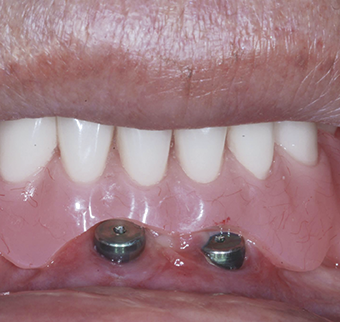Flexible procedures
Simple prosthetic solutions in complex cases for a successful overdenture by Dr Emiliano Ferrari and Gianni Storni
Prosthetic-driven positioning of implants allows both the technician and the dentist to rehabilitate patients with prostheses, while respecting the basic rules of biomechanics and aesthetics. Due to insufficient bone tissue as a result of post extraction regeneration, or to the functional remodelling of the alveolar bone in tissue-supported prosthesis wearers, it is not always possible to insert fixtures in the desired position or with the preferred inclinations without resorting to surgical treatment.
In this case, the dentist is faced with the possibility of performing regeneration procedures of varying degrees of complexity. Another possibility is to place implants where there is sufficient bone available to manage the compromise with a suitable prosthetic device. In the case to be described, it was necessary to modify a new prosthesis in order to reposition implants presenting in an unfavourable anatomical situation without regeneration.
The patient – female, 60 years old, non-smoker and in good health – has worn a total prosthesis for many years. She had recently received two new prostheses to replace the previous ones. These prostheses seem correct in terms of aesthetic appearance. However, poor stability was a concern. The patient subsequently changed her mind, choosing to proceed with implant insertion.
Anatomical conditions appeared compromised: the mandibula had severe bone atrophy in the posterior region and in the intraforaminal zone, complicated by severe skeletal Class III. During the initial phase of the surgery, a full thickness flap was lifted. After levelling the ridge, two implants were positioned in an area where the bone had sufficient thickness, height and consistency.
Surgery was performed in two phases, as covering the implants with soft tissues ensure healing without occlusal trauma. When the implants were uncovered and the healing screws positioned, the dimensions of the prosthesis were evaluated. The implants resulted to be by a vestibular level compared to the lower mounting middle ridge, as much to emerge completely within the vestibular flange in resin (Fig 1).
It was decided not to proceed with a single abutment rehabilitation process considering the uncertain aesthetic and functional outcomes as well as the excessive fragility of the buccal flange when subjected to masticatory loads (Fig 2). The only possible solution, considering the minimal space available, was the construction of a UCLA Bar, using the new low profile castable Equator attachments. (Fig 3) The silicon mask of the pre-existing prosthesis was necessary in order to assess the available space.
The use of the castable attachments allowed for an increase of the stability of the prosthesis, by positioning them on a virtual connective line in order to create the famous ‘stability area’ (Figs 4 and 5). Once the bar was cast, the process was halfway to completion (Fig 6). Since a full resin prosthesis would most probably break in a short amount of time, a reinforcement structure using pre-fabricated castable components directly on the master model was performed.
The main objective was to use every single millimeter of space available. Wax was used to eliminate the external retentive zones outside the metal housings, which were inserted on the Equator ‘males’ (Fig 7). The structure was then completed with a distal extension covering the entire bar using resin in order to obtain the space to paste the containers in a passive connection once the reinforcement structure was cast (Figs 8 and 9).
The metal structure was then pre-covered with pink opaque material and then inserted on to the pre-existing prosthesis (Figures 10 and 11). Once the modeling process was complete, the black caps, used for laboratory phases only, were replaced with the final caps choosing the proper retention (Figure 12).
Comparing the initial situation (no bar) with the final result (with the inserted reinforcement bar –see Figure 13), it was evident that, by performing an extremely simple procedure, a solid prosthesis with stability and very satisfactory aesthetic result was achieved. It was possible to bring the area of retention into the middle ridge, despite a clear vestibular emergence of the implants (Figures 14 and 15).
The patient’s desire to maintain the existing prosthesis was respected, with patient satisfaction being the primary objective of the work carried out. To achieve this, the best materials and products on the market were selected.
Experience and communication with the patient were both important in order to reach the expected result. As well as ideal treatment plans for the edentulous patient, there is an ideal treatment plan which is appropriate for ‘that’ individual partially edentulous patient.
